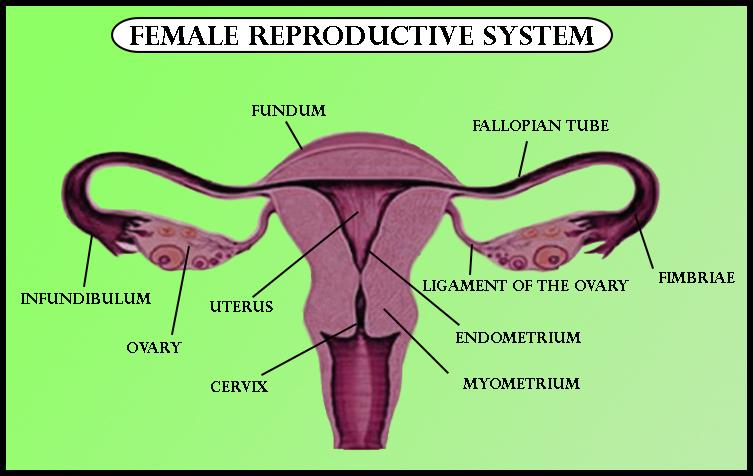
Describe the female reproductive system of a woman with the help of a labelled diagram.
Answer
413.2k+ views
Hint: The female reproductive system is enclosed to perform different functions. They form egg cells that are important for reproduction known as ova. The system is arranged to deliver the ova to the region of fertilization.
Complete answer:

The female reproductive system is active before, during and after fertilization as well. It consists of the following parts:
A pair of ovaries: Ovaries produce and store ovum in them. They also produce a female hormone called estrogen. There is one egg produced and released every month.
Fallopian tubes (Oviducts): They are the site of fertilization. They connect ovaries with the uterus. There are three parts of the fallopian tube, infundibulum, ampulla and isthmus. The ampulla is the site of fertilisation of the egg and the sperm.
Uterus: This is the sac-like structure in the lower part of the abdomen in the female body. Uterus is the site of development for the embryo. This is the structure which is involved in the implantation of the foetus. The bag holds the developing embryo during the period of gestation.
Cervix: This is the structure which is present at the lower region of the uterus. The cervix opens to allow the entry of sperm and during the child birth.
Vagina: It is the part which connects the cervix to the external female body parts. It is the route for the penis during coitus as well as a fetus during delivery. This is also called the birth canal through which the child comes out.
Additional Information: Female reproductive system has two functions –
-Production of female gametes called ovum/egg.
-Providing nutrition and protecting the developing embryo.
During puberty, eggs in the ovaries start to mature. One of the ovaries releases the mature ovum every 28 to 30 days and is called ovulation.
Note: The process of fusion of sperm with egg (ovum) to produce zygote is called fertilization. Fertilization is a crucial stage of reproduction in human beings. The fertilized egg is called the zygote. Zygote starts to divide into many cells and develops into an embryo.
Embryo moves into the uterus and gets attached to its walls. This process is referred to as implantation, and the implanted embryo eventually develops into a fetus.
Complete answer:

The female reproductive system is active before, during and after fertilization as well. It consists of the following parts:
A pair of ovaries: Ovaries produce and store ovum in them. They also produce a female hormone called estrogen. There is one egg produced and released every month.
Fallopian tubes (Oviducts): They are the site of fertilization. They connect ovaries with the uterus. There are three parts of the fallopian tube, infundibulum, ampulla and isthmus. The ampulla is the site of fertilisation of the egg and the sperm.
Uterus: This is the sac-like structure in the lower part of the abdomen in the female body. Uterus is the site of development for the embryo. This is the structure which is involved in the implantation of the foetus. The bag holds the developing embryo during the period of gestation.
Cervix: This is the structure which is present at the lower region of the uterus. The cervix opens to allow the entry of sperm and during the child birth.
Vagina: It is the part which connects the cervix to the external female body parts. It is the route for the penis during coitus as well as a fetus during delivery. This is also called the birth canal through which the child comes out.
Additional Information: Female reproductive system has two functions –
-Production of female gametes called ovum/egg.
-Providing nutrition and protecting the developing embryo.
During puberty, eggs in the ovaries start to mature. One of the ovaries releases the mature ovum every 28 to 30 days and is called ovulation.
Note: The process of fusion of sperm with egg (ovum) to produce zygote is called fertilization. Fertilization is a crucial stage of reproduction in human beings. The fertilized egg is called the zygote. Zygote starts to divide into many cells and develops into an embryo.
Embryo moves into the uterus and gets attached to its walls. This process is referred to as implantation, and the implanted embryo eventually develops into a fetus.
Recently Updated Pages
Basicity of sulphurous acid and sulphuric acid are

Master Class 12 Economics: Engaging Questions & Answers for Success

Master Class 12 Maths: Engaging Questions & Answers for Success

Master Class 12 Biology: Engaging Questions & Answers for Success

Master Class 12 Physics: Engaging Questions & Answers for Success

Master Class 12 Business Studies: Engaging Questions & Answers for Success

Trending doubts
Which are the Top 10 Largest Countries of the World?

Draw a labelled sketch of the human eye class 12 physics CBSE

Differentiate between homogeneous and heterogeneous class 12 chemistry CBSE

What is a transformer Explain the principle construction class 12 physics CBSE

What are the major means of transport Explain each class 12 social science CBSE

What is the Full Form of PVC, PET, HDPE, LDPE, PP and PS ?




